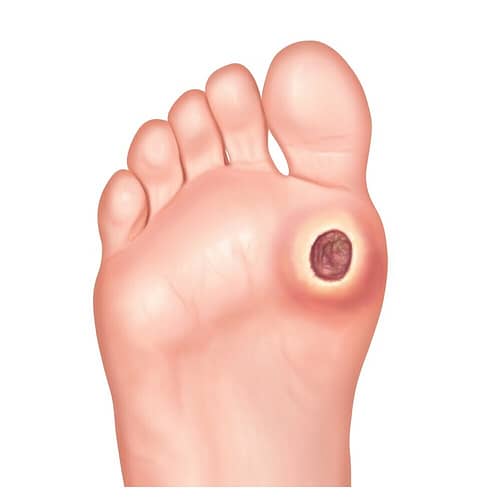
Tips For Preventing And Treating Foot Ulcers
Preventing and treating foot ulcers is a topic I’ve become intimately familiar with, both through personal experience and helping loved ones manage this condition. While they might seem like a minor issue, foot ulcers can have serious consequences if left untreated.
Preventing and Treating Foot Ulcers: Essential Steps for Healthy Feet
Foot ulcers might not be dinner-table conversation, but they’re pretty important if you’re looking to keep your feet happy and healthy. Foot ulcers are basically open sores on your feet or toes that refuse to go away, and they’re not just a minor inconvenience. Left unchecked, they can cause bigger issues like infections or even lead to amputations.
The causes of foot ulcers can be as varied as the people who experience them. You’ve got diabetes, poor blood circulation, and nerve damage (a.k.a. neuropathy) sitting at the top of the list. Neuropathy can sneak up on you if you’ve got diabetes because it damages the nerves responsible for feeling pain, making it tough even to notice something’s wrong till it’s too late.
Risk factors are kind of like a checklist of things to look out for. Age, body weight, and pre-existing conditions like heart disease or kidney problems all bump up your chances of getting stuck with a foot ulcer. It’s like your feet are shouting a call for help, only it’s in Morse code!
The secret weapon in your foot care arsenal is early detection. Spotting an ulcer early means you can jump on treatment fast, which is crucial for nipping it in the bud before it gets troublesome. Regular foot checks—either by yourself or a healthcare professional—are a game-changer. A little time spent with your feet today could save you a whole lot of hassle tomorrow.
Key Takeaways on Foot Ulcers
- Know the Risks: Foot ulcers often result from diabetes and neuropathy. Early signs like redness or swelling should prompt self-checks.
- Prevent with Care: Good foot hygiene, proper footwear, and regular check-ups can help prevent ulcers.
- Act Quickly: Timely treatment, including wound care and possibly advanced therapies, is crucial for healing.
Essential Tips for Preventing Foot Ulcers
Foot hygiene might sound like something only your grandma talks about, but keeping your feet clean and dry is like basic maintenance for your car—neglect it, and you’re asking for trouble. Not just washing, but really getting between those toes, drying them thoroughly, and chucking on some moisturizer can keep the skin soft and less prone to cracking.

Choosing the Right Footwear
Footwear matters more than you might think. Those fancy shoes might turn heads, but they also might be squeezing your feet where they shouldn’t. Opt for shoes that provide room and support, maybe something with a bit of cushioning to absorb the shocks of everyday life. Shop for shoes in the afternoon when your feet are naturally a bit swollen; it’s a minor detail that makes a big difference.
Regular Foot Check-ups
Regular check-ups with someone who knows feet like the back of their hand is like having a relationship with your mechanic—you want them to spot issues before they become costly problems. A healthcare provider specialized in foot care can catch potential problems early and help tailor a care plan specific to your needs.
Embracing a Healthy Lifestyle
A healthy lifestyle is another step in the right direction. Think of it as a holistic approach. Managing your blood sugar levels, cutting down on fried foods, and moving more are all in the game plan. If you smoke, it’s time to consider quitting. Smoking messes with your blood circulation, making it harder for your body to heal itself.
Being Proactive with Health
Being proactive with your health, especially if you’ve got diabetes or other underlying conditions, changes the game. Regular monitoring of your condition is the name of the game here, keeping everything in check to prevent those ulcers from showing up in the first place.
Recognizing Early Signs and Symptoms of Foot Ulcers
Foot ulcers can be sneaky, so knowing what to watch for is crucial. Starting with what’s right under your nose—or in this case, your feet—any sudden redness or swelling should raise a flag. An unusual warm spot on the foot can also mean trouble’s brewing, even if there’s no open sore yet.
Pain might seem obvious, but with conditions like neuropathy, it might be a lack of pain that’s worrisome. If you usually have sensation and suddenly don’t, it’s a hint that something’s up. A little throbbing pain that seems out of place can also be a warning sign that an ulcer might be forming.
Getting into the routine of daily self-examinations is like brushing your teeth. Quick and daily means problems are less likely to stick around. Look out for cuts, blisters, or any changes in the skin. Using a mirror or getting help from a friend is helpful if you can’t see everything on your own.
Escalate things to a professional if your home detective work uncovers something suspicious. Medical experts can offer tests and use tools we simply don’t have at home—like ultrasounds or blood tests—to pinpoint the underlying issue.
Tools like a foot mirror or apps designed to remind and track changes can be your best friend. You can even keep a little foot diary to note any changes over time, giving your doctor valuable info when you see them next.
Effective Treatment Options for Foot Ulcers
Once an ulcer appears, addressing it promptly is essential. Tackling foot ulcers takes a mix of professional care and personal vigilance. Medical treatments span a range from simple to high-tech, but starting with the basics is key.

Wound Care Basics
Wound care tops the list. Keeping the ulcer clean and covered is paramount. Use sterile dressings and follow your healthcare provider’s advice on changing them. This prevents infection and encourages the healing process.
Managing Infections
When infections rear their ugly heads, antibiotics come into play. Whether oral or topical, they help clear infections out of the way, paving the path for your skin to heal without interference.
Advanced Treatment Options
In more advanced cases, you might find yourself exploring options like hyperbaric oxygen therapy. This involves breathing pure oxygen in a pressurized room, aiding faster healing. Though it might sound futuristic, it’s been a reliable treatment for severe ulcers.
Considering Skin Grafts
Skin grafts can also be a game-changer in persistent cases. They involve transplanting skin, either your own or from a donor, to the ulcer area to encourage healing. Chat with your healthcare provider about these options if you’re hitting bumps in the healing road.

Living with and Managing Foot Ulcers
Managing foot ulcers day-to-day can seem daunting, but establishing a practical routine makes it far more manageable. A morning and evening routine for foot care, like self-checks and dressing changes, ensures you’re actively monitoring any changes.
Eating well is more than just a diet trend. A balanced diet, rich in vitamins and nutrients, supports your body’s natural healing process. Integrating foods like fruits, vegetables, and lean proteins can give your body the tools it needs to repair itself.
Mental health can sometimes get sidelined when dealing with physical health issues, but staying mentally well is just as critical. Finding support from others dealing with similar issues can be uplifting. Whether through in-person groups or online communities, connecting with those who understand can provide peace of mind.
Success stories from others who have effectively managed their ulcers might sound cliché, but they offer valuable insights and inspiration. Learning what works—how others build routines or the lifestyle changes they’ve made—can motivate you and show that it’s possible to live well despite the challenges.
It’s about progress, not perfection, so celebrate small victories as you make strides in managing your condition. It’s easy to get discouraged, but recognizing each step forward helps keep your spirits up as you continue on this health journey.
Preventing and Treating Foot Ulcers: Your Path to Healthy Feet
In conclusion, preventing and treating foot ulcers is essential for maintaining overall foot health and well-being. By understanding the risk factors, practicing good foot hygiene, and seeking timely medical attention, you can significantly reduce your risk of developing these painful and debilitating wounds. Remember to regularly inspect your feet for any signs of redness, swelling, or open sores. If you have diabetes or poor circulation, it’s crucial to prioritize foot care and work closely with your healthcare provider to develop a personalized treatment plan.
Thank you for taking the time to learn more about foot ulcers. We hope this information empowers you to take proactive steps towards maintaining healthy feet for yourself and your loved ones. By making small changes to your daily routine and seeking appropriate medical care, you can prevent and effectively manage foot ulcers.
Frequently Asked Questions
Preventing and treating foot ulcers is a critical aspect of maintaining healthy feet, especially for those at higher risk. Knowing the causes, practicing prevention, and understanding treatment options can make a significant difference. Here are some frequently asked questions to help you navigate this journey to healthier feet.
What causes foot ulcers, and who is at risk?
Foot ulcers can result from various factors, including diabetes, poor circulation, and nerve damage (neuropathy). People with conditions like diabetes, heart disease, or kidney issues, and those who are older or overweight, are at higher risk.
How can I prevent foot ulcers from forming?
Preventing foot ulcers involves maintaining good foot hygiene, wearing supportive footwear, conducting daily foot checks, and scheduling regular appointments with a healthcare provider. A healthy lifestyle, including blood sugar control and quitting smoking, can also reduce risks.
What are the treatment options if I already have a foot ulcer?
Treatment for foot ulcers typically includes wound care, antibiotics for infection, and in advanced cases, therapies like hyperbaric oxygen or skin grafts. Early detection and medical guidance are essential for effective healing and to prevent complications.
Stay Empowered in Foot Health and Fitness!
As you take steps to prevent and treat foot ulcers, it’s essential to have the right support and resources. Join our community for engaging content, expert product reviews, and tips focused on elderly fitness and overall well-being. Visit our official site and connect with us on Facebook to stay informed and motivated on your health journey!


























